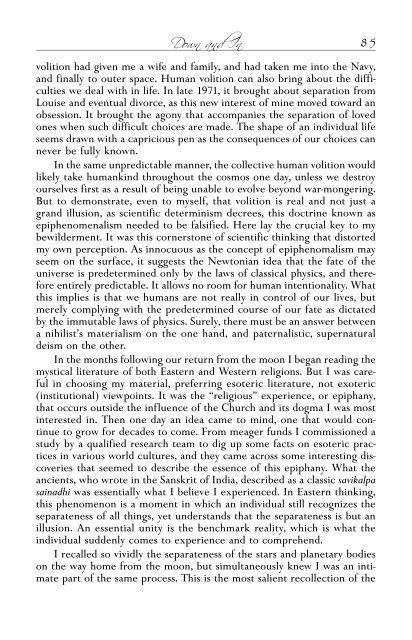edgar-mitchell
edgar-mitchell
edgar-mitchell
You also want an ePaper? Increase the reach of your titles
YUMPU automatically turns print PDFs into web optimized ePapers that Google loves.
Sea of Sky 43<br />
reputation that preceded him. As it turned out, von Braun was a peacefulminded<br />
man intimately concerned with the manner in which we would<br />
explore the cosmos, and he was leading the team that would build the<br />
launch machinery to take us there. He was also singularly passionate about<br />
his work. I came to learn that much of the lore surrounding von Braun<br />
was merely misinformed gossip. Many saw him as a thinly disguised and<br />
secretly unrepentant Nazi employed by the U.S. government, not the brilliant<br />
engineer who, as a young man, had his talents exploited by a totalitarian<br />
regime.<br />
His life was larger, more dramatic than I thought possible. It was<br />
Wagnerian, operatic. While still a teenager, von Braun began his career in<br />
rocketry building the German Repulsor rocket for the legendary Hermann<br />
Oberth. As Hitler and his Brown Shirts came to power, von Braun’s small<br />
group of engineers found financial backing in the Third Reich for their<br />
wild dream of one day sending men into outer space to explore the cosmos.<br />
During the war years, their designs for the A-1 and A-2 rockets (renamed<br />
the V-I and V-2 by Hitler himself) evolved light-years ahead of their<br />
counterparts in the Soviet Union and the United States. (American designs<br />
were under the auspices of the brilliant but reclusive Robert Goddard<br />
in New Mexico.) The V-1 and V-2 rockets weren’t effective militarily, as<br />
they couldn’t carry a large payload of explosives, and weren’t especially<br />
accurate. Moreover, production was peculiarly slow, which drew the<br />
suspicion of the military men. Finally, on March 15, 1944, von Braun<br />
was arrested by the S.S. and accused of sabotaging the rocket program. When<br />
asked how he had sabotaged it, the S.S. officer claimed that von Braun had<br />
been building rockets for the purpose of space travel all along, not warmaking.<br />
But von Braun’s boss, Walter Dornberger, insisted that such work did<br />
not constitute sabotage, and gradually the S.S. gave up its case against the<br />
young engineer. All of this was eventually neither here nor there, as von Braun<br />
and his team began actively—but secretly—seeking out the advancing American<br />
forces, rather than surrender to the Soviets coming from the East.<br />
When they finally achieved their objective, just before the close of the<br />
war, von Braun was sent to the States, to White Sands Proving Grounds in<br />
New Mexico, not far from my hometown of Roswell. In the years succeeding<br />
the war, he expressed his wish to build his huge A-9 and A-10<br />
rockets, which had been on his personal drawing board for years. He believed<br />
these immense rockets would be capable of sending large payloads,<br />
and men, into space. But, of course, the U.S. military wasn’t interested,<br />
just as his former military bosses were not. What they wanted was a marriage<br />
between the two great military technologies that had come out of<br />
World War II—the rocket engine and the atomic bomb. They wanted ICBMs<br />
for a cold war. Space exploration would have to wait.


